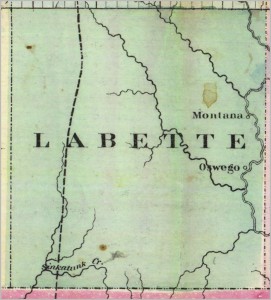Labette County, Kansas

- Formed: February 7, 1867
- County Population 1860: NA
- Civil War Engagements
-Burning of Chetopa, November 1863
– Suffered constant guerrilla warfare
Image courtesy of Wichita State University Special Collections
Labette County, Kansas was originally part of Dorn (later Neosho) County, which was part of the Osage Ceded Lands. The land was set aside for the Osage Nation when they were forced out of their traditional homelands in Missouri and Arkansas. The Osage eventually ceded these lands to the United States government in 1867. The earliest settlers, most of who settled in the area illegally as it still belonged to the Osage, were traders who established trading posts. In order to obtain legal permission to settle in the county, settlers had to obtain written permission from the Osage Indian Agent, A.J. Dorn. John Matthews, a trader who settled near present day Oswego, came to the area in 1840. In 1853, Dr. George Lisle, originally from Ohio, obtained permission from Dorn to settle in the area. Other early settlers in the 1850s included G. Hanson, William Doudna, George Walker, Larkin McGee, and J.P Barnaby, Ed and George Cubbison. Labette County is located among abundant sources of fresh water, including the Neosho River and the Big Labette, Little Labette, Hackberg, Snow, Pumpkin, and Big Hill Creeks. Walnut, oak, and sycamore timber is very abundant in the area. It also contains limestone and sandstone for building. The soil is suitable for growing oats, wheat, corn, potatoes, sorghum, cotton, flax, tobacco, grazing grasses, millet, and castor beans.
Settlement in the Labette County area (then the southern part of Dorn County, named after Osage agent A.J. Dorn) was sparse during the Civil War, with most of the population living further north. Most of the residents in the county area sided with the Union. However, John Matthews supported the Confederacy and formed a small Confederate guerrilla band. Throughout the war, Matthews and his guerrillas terrorized other citizens who were Union supporters. Matthews was eventually captured and killed by Union troops under Colonel Blunt. By 1865, there were only two non-Native American settlers in the Labette County area left, S.M. Collins and A.T. Dickerman.
After the war’s conclusion in 1865, many settlers who had fled during the war returned. They found almost everything was destroyed, and most again decided to move elsewhere. When treaty negotiations with the Osage to cede their land began in 1865, most people believed that the Osage Lands would soon belong to the United States. The Labette County area received its first rush of settlers in 1866, most of who were first time settlers to the area. These included: J.C. Rexford, C.C. and D.M. Clover, A.P. Elsbee, C.E. and B.F. Simmons, Norris Harrar, Grant Reaves, William White and his sons, John Modesitt, and Calvin Watkins.
This population boom in the area set off conflicts between the Osage and the settlers. The Osage demanded that their agent, a Mr. Snow, require that all settlers who had settled illegally (most of them) leave the territory immediately. Negotiations with the Osage and the settlers continued throughout 1866, and they eventually reached the compromise that the settlers could remain in the area as long as they paid rent to the Osage tribe.
This compromise was short-lived, as the Osage ceded their lands to the United States in early 1867. The settlers in the area demanded that they become their own county, rather than just the southern portion of Dorn County (which, in the same year, became Neosho County). This request was granted, and Labette County was officially organized on February 7, 1867. The name came from a French explorer and trader, Pierre LaBette, who traveled in the area in the early 1800s. The Big and Little Labette Creeks were named after him, and the county was named after the creeks. The County seat was named Oswego. Several townships were established, including: Fair View, Liberty, Labette, Hackberry, Montana, Mound Valley, Canada, Mount Pleasant, Mound Valley, Osage, Neosho, Oswego, and Walton.
 Browse all collections in Labette County
Browse all collections in Labette County
- Consulted:
- http://skyways.lib.ks.us/counties/LB/
- William G. Cutler, History of the State of Kansas (Chicago: A.T. Andreas, 1883). Accessed through:
- http://www.kancoll.org/books/cutler/labette/labette-co-p1.html
- http://www.kshs.org/genealogists/places/counties.php?county=LB
- Nelson Case, History of Labette County, Kansas from the First Settlement to the Close of 1892 (Topeka, KS: Crane and Company Publishers, 1893) Accessed Through:
- http://books.google.com/books?id=T2QAAAAYAAJ&pg=PA157&dg=neosho+county+kansas+history&1r=&cd=1=V=onepage&of=neosho%20county%20kansas%20history%F=false












